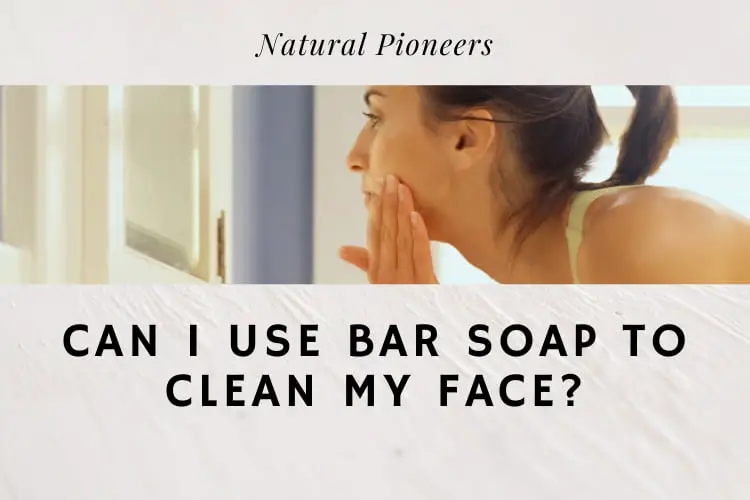
Minimalism is IN! So, why not use bar soap for face, body & hands instead of having to buy 3 different products? Let’s find out what bar soap is, how it affects our skin, and if a cleanser or face wash would be better.
Bar soap can be used to wash your face. However, the formulation of a soap, cleanser, or face wash is crucial for the health of our skin. The ideal product is non-toxic, with a pH of ≤ 5, and contains added hydrating & moisturizing ingredients.
Let’s first find out what the difference is between a soap, cleanser, and a face wash.
1. Bar Soap vs. Cleanser vs. Face Wash
Bar soap is a combination of fats or oils with an alkali (lye).” [1]
All natural soap – liquid or bar soap – is made during the saponification process. Saponification means “soap making”, and is a chemical reaction that occurs when fats or oils come into contact with an alkali.
So, remember: No Lye, No Soap!
What’s special about bar soap?
Let’s find out and check the list of benefits of bar soap.
Benefits Of Bar Soap
- Bacteria are not transferred from person to person through bar soap. Hence, bar soap is just as sanitary as liquid soap. [2], [3]
- A good (natural) soap contains glycerin and 1-20% of nourishing “superfat”. [4]
- Bar soap generally contains significantly fewer toxins. Non-toxic products are ideal.
- Bar soap production requires significantly less chemical raw materials.
- Bar soap is generally wrapped in eco-friendly paper (no plastic bottles).
- Next to its eco-friendly paper, the amount of packaging material is significantly lower.
- Researchers found that when washing, we use more liquid soap than bar soap, that means bar soap will last us much longer.
- When considering the carbon footprint, bar soap is more efficient to transport and comes without the plastic container which is not completely recyclable.
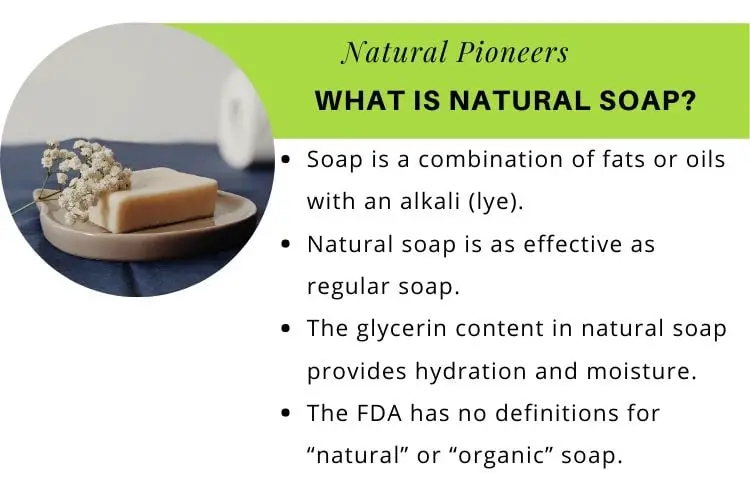
>> Learn more about natural soap
The alternative to soap is a face wash or a cleanser.
But what is the difference between a cleanser and a face wash?
Face washes foam upon application and need to be washed off, while cleansers usually have a lotion-like consistency and can be washed or wiped off. It is commonly said that cleansers are much milder on the skin than a face wash. And are ideal for those with dry or sensitive skin and are just as effective as a face wash.
So why even considering a face wash, you ask?
When researching the websites of popular face wash brands, they will tell you that face washes are perfect for those with oily or combination skin. Plus, if you spend a lot of time outdoors and use a lot of makeup a face wash apparently is the better choice.
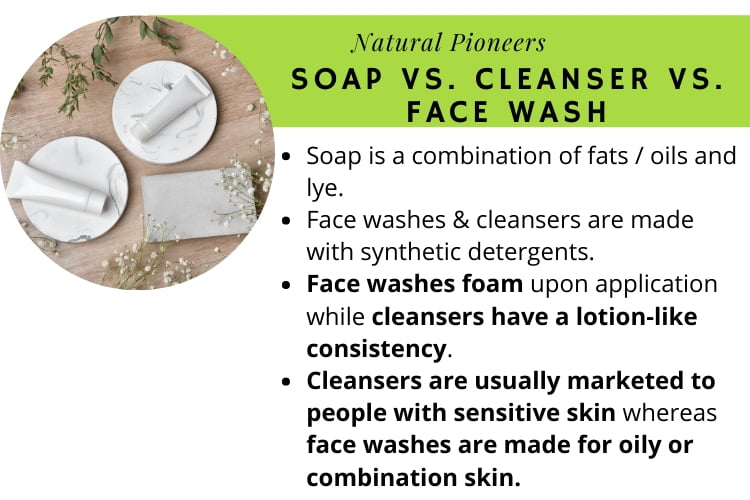
The difference between a face wash and a cleanser is that a face wash thoroughly cleans dirt and oil and is more harsh than a cleanser. A cleanser is ideal if you spend most of your time inside with little makeup and have sensitive or dry skin.
Both, cleansers and face washes are made from synthetic detergents. And while some brands claim that a face wash is only for oily skin, and a cleanser for sensitive skin, it depends on the composition. Hence, not all cleansers are as gentle as they say, nor are all face washes harsh. We’ll get into the nuts and bolts of choosing your ideal product in the following chapters..
The Take-Away: Soap is made with fats or oils and lye, and can easily be made at home. Face washes and cleansers, on the other hand, are made with synthetic detergents. From an environmental perspective, bar soap is the clear winner requiring significantly less chemical raw materials, being wrapped eco-friendly paper, and being more efficient to transport. Research also shows that bar soap lasts significantly longer as we use less.
But is bar soap also ideal when it comes to washing our face? I suggest we look at this from our skin’s perspective and make an educated choice based on what’s best for our skin.
2. Special Needs Of Our Facial Skin
Let’s see which of our options including bar soap, cleansers or face wash, are best for our facial skin. Overall, we first need to know what “healthy skin” is and how to achieve and maintain it. There are several factors we need to take into consideration here.
If we take a look at the University of Washington’s definition,
“Healthy skin is smooth, with no breaks in the surface. It is warm (not hot or red) and neither dry and flaky nor moist and wrinkled. Healthy skin is a mirror of a healthy body.“ [5]
So far, so good, but what characteristics are we looking for?
Studies show, that the most important biophysical parameters are the skin pH, epidermal hydration, transepidermal water loss and sebum excretion. [6]
Alright, there we have it. Let’s see what these 4 terms mean and how we can influence them.
A Healthy Skin pH
The pH is a scale used to specify how acidic or basic something is. Anything between 0 and 6.9 is acidic, 7 is neutral and anything between 7.1 and 14 is considered alkaline. Studies show, that normal skin surface pH is between 4 and 5 in healthy people. [7], [8]
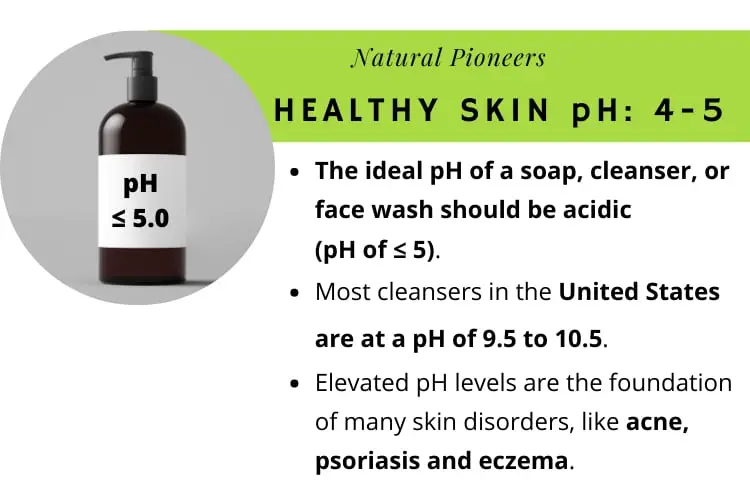
>> Learn more about the pH of shampoos
Our skin is the first line of defense against microorganisms, wind, pollutants and more. It is our skins acid mantle that really does the job. The acid mantle is a fine film with a slightly acidic pH on the surface of the skin and provides ideal protection.
So far, we’ve learned that our skin is naturally acidic. It probably comes as no surprise that anything we use to wash our face should not disturb the protective acid mantle.
The ideal pH of a cleaning product (soap, cleanser, or face wash) should be acidic, that means it should have a pH of ≤ 5. [9]
However, the market in the United States carries very few low-pH soaps, cleansers, and face washes. In fact, most cleansers in the United States are at a pH of 9.5 to 10.5. [10]
If we use an alkaline product to clean our face, the skin’s acid can be damaged, the protective acidity is lost, and the skin becomes more prone to damage and infection. Once damaged, it can take up to 14 hours to restore, by which time, we most likely wash our face already again. This literally begins to erode your skin’s structure. It runs dry and looses its hydration.
Why are alkaline products so bad?
Because it is the foundation of many skin disorders, like acne, psoriasis and eczema. Studies show skin disorders like acne occur more often when our skin pH is more on the alkaline side. Which is the case when we use highly alkaline products. [11]
Remember: Studies have shown over & over that the closer a products pH is to our skin, the healthier it is! [12]
So, what does that mean for bar soap, face wash, and cleansers?
Interestingly, you can find soaps, face washes, and cleansers with the right pH. How do I know? Well, having grown up in Germany, I know that Europe (and Asia) offer a broad range of liquid washes and soaps with a pH of 5.5. [13]
“Soap isn’t necessarily bad for acne, but the wrong type of soap or cleanser can irritate the skin, making acne worse or making it difficult to use appropriate acne medications — many of which are drying.” [14]
Dr. Kathleen Welsh, board-certified Dermatologist
One option we haven’t really looked at are syndet bars. They are also labeled as “facial bars” or ”soap free bars”. The word syndet comes from synthetic detergent. To make it short, while soaps require lye which is highly alkaline, chemically produced detergents can be made as a bar which has pH levels close to the ideal (slightly acid). Dermatologists often recommend syndets, as they are the most gentle to sensitive skin. [15], [16], [17]
Fun fact: tap water has a pH of around 8!
While it is important to choose the right product, let’s put this into perspective. Tap water has a pH of around 8. Yes, that means even if you’ve chosen the right pH product, washing your face with tap water will increase your skin’s pH. It takes up to 6 h until our skin is back to its natural value of on average below 5.0. [18]
The Take-Away: Choose a product with a pH of ≤ 5.
Epidermal Hydration & Transepidermal Water Loss
Our skin has the ability to stay hydrated by itself. Water originates in the deeper skin layers and moves upward to hydrate all layers of our skin. The key is to keep it there and not lose the hydration. Dermatologists often use the term TEWL (transepidermal waterloss) which is the amount of water that passively evaporates through skin to the external environment.
So, how can a cleaning product help our skin stay hydrated?
Well, there are two sides to hydration. One is to provide the body with enough fluids (and a healthy lifestyle) so that it can produce hydration itself. Another is to ensure, that we hydrate our skin from the outside and make sure we lock the moisture in (moisturizing).
Hydrating means infusing our skin with water & improving our skin’s ability to absorb moisture and nutrients. Whereas moisturizing is about sealing the moisture. This allows your skin to develop a protective barrier. [19]
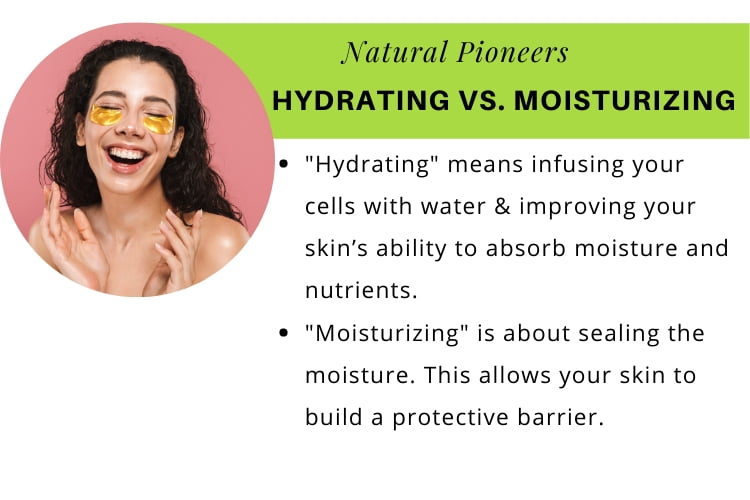
So how can a facial cleaner help us with hydration & moisture?
Soaps, cleansers, and face washes are available with hydrating and moisturizing ingredients. Let’s see what they are: [20]
Hydrating Ingredients:
- Hyaluronic Acid
- Glycerin
- Aloe
- Honey
- Snail Mucin
- Lactic Acid
- Citric Acid
Moisturizing Ingredients:
- Nut or Seed Oil (Coconut, Almond, Hemp…)
- Shea Butter
- Plant Oils (Jojoba, Rose Hip, Tea Tree)
- Mineral Oil
- Lanolin
- Lactic Acid
- Citric Acid
So far, soaps, cleansers, and face washes all remain suitable options as long as their pH is below 5, and they are packed with hydrating & moisturizing ingredients. We will show you our list of ideal products at the end of our article.
The Take-Away: Choose a soap, cleanser, or face wash with added hydrating & moisturizing ingredients for healthy & hydrated skin.
Sebum Excretion & Why It’s Important
Sebum is the oily, waxy substance that our skin produces to lubricate the skin. People with oily skin suffer from excessive sebum production while people with dry skin produce too little sebum. [21]
“Essentially everyone has combination skin, and I would say you’re on the very low end of that spectrum — your skin is extremely normal all over. The area of the face with the greatest density of sebaceous glands is in your T zone — your nose probably has the most.” [22]
Adarsh Vijay Mudgil, MD – New York based Dermatologist
Therefore, healthy skin produces just enough sebum to ideally moisturize your skin. But not as much to make it appear oily.
What we use to wash our face has quite an impact on sebum production. And you might have experienced this yourself: When we use products that are too harsh and strip the oils on our skin, we notice how our skin begins to excessively produce sebum. Resulting in an oily T-Zone (forehead, nose, and chin) only 30 minutes after washing our face.
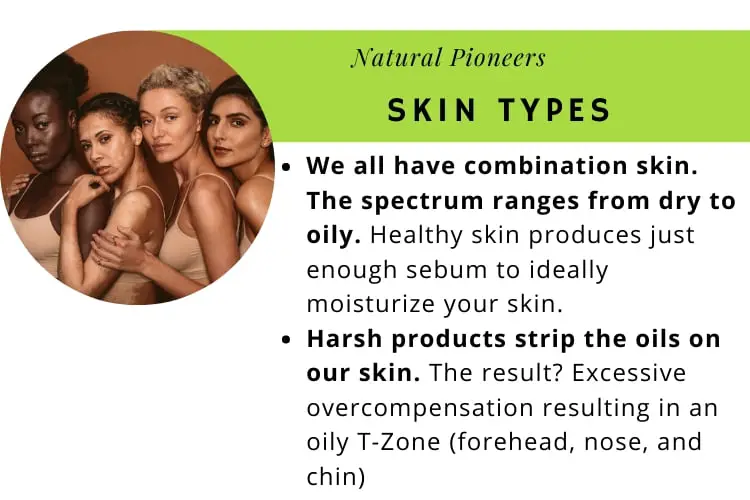
>> Learn more about bath salts for dry skin
In oily skin, the ideal cleanser removes excess oil and shows a continuous degreasing effect without any overcompensation of sebum. [23]
Studies show that products without SLES can achieve this and are advantageous for sensitive skin. [24]
SLES is a surfactant (a SURFace ACTive AgeNT) and commonly used in cleaning products for our face, body, dish detergent, multi-purpose cleaners, etc. It is toxic and comes with severe side effects. We will cover toxins in our facial products in the next chapter. Non-toxic, sulfate-free products should be the only choices to consider.
The Take-Away: Make sure your product is sulfate-free for a healthy sebum production and balanced skin.
Let’s sum up our learnings about the special needs of our face and look for an ideal product that covers it all.
Conclusion: Studies show, that the most important biophysical parameters of healthy skin are the skin pH, epidermal hydration, transepidermal water loss and sebum excretion. Choosing a sulfate-free product with a pH of ≤ 5, and added hydrating & moisturizing ingredients is ideal for healthy skin.
3. Ideal Characteristics Of A Cleanser
As determined in our past chapters, the ideal product should be sulfate-free with a pH of ≤ 5, and added hydrating & moisturizing ingredients.
Before we dive excellent products to wash your face, let’s take a look at possible toxins in our products, how they can affect our health, and how to avoid them.
Toxins In Soaps, Cleansers, And Face Washes
There are many studies on this topic and you might have come across the EWG Skin Deep Database. I recommend you check the safety of all the product you currently use in their database. You can find a link here. Now, let’s see what scientists can tell us about toxic ingredients in our personal care products.
- Studies show that chemicals found in cosmetics and personal care products may not only act as hormone disruptors but may also cause reproductive problems. Children are generally exposed to the same chemicals as their mothers. [25]
- Another study done on pregnant women could find chemicals in urine samples and could trace them back to their use of liquid soap, sunscreen, lotion and cosmetics. [26]
- Generally, women of color have show higher levels of chemicals from beauty products in their bodies when compared with white women. [27]
>> Learn more about toxins in shampoos
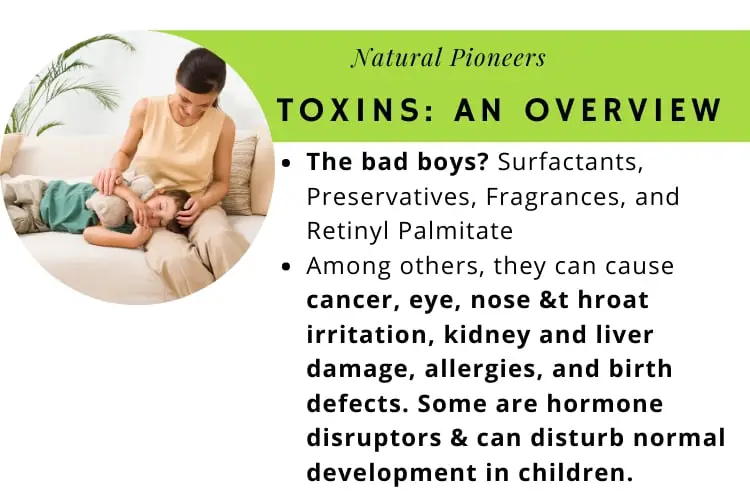
As you can see, most commercially produced products and cosmetics contain significant amounts of toxins that are absorbed through our skin. They are known to cause cancer, can cause developmental & reproductive problems, cause allergies, or harm our immune system. [28]
If you find yourself super worried right now, breathe. You can take active steps towards minimizing the chemical load you expose yourself to. Let’s reveal the toxins in our products, and look at non-toxic, sulfate-free, ph-balanced & moisturizing products right after. Phew, we’ve collected a pretty long list of criteria here.
1. Surfactants
Surfactants increase the spreading properties of a product. Some produce bubbles, that we all enjoy when washing our face. During production 1,4-dioxane is formed which is known to cause cancer. It is banned from use in the European Union. Short-term exposure may cause eye, nose, and throat irritation, long-term exposure may cause kidney and liver damage. [29], [30]
The Bad Boys: Sodium lauryl sulfate (SLS), sodium laureth sulfate (SLES), cocamidopropyl betaine, and cocamide DEA. Non-toxic, safe surfactants include decyl glucoside and laurel glucoside.
The Take-Away: Use sulfate-free products.
2. Preservatives
To extend shelf life, many products contain preservatives. Some may cause breast cancer, are associated with immunotoxicity and allergies, or are neurotoxins. [31], [32], [33]
The Bad Boys: Parabens, benzyl alcohol, methylisothiazolinone, and methylchloroisothiazonlinone.
The Take-Away: Avoid preservatices at all cost and check out our list of safe, non-toxic products at the end of this article.
3. Fragrances
When you see “fragrance” or “parfum” on the ingredients list, they really mean phthaltes. Phthaltes disrupt our hormones and can harm our reproductive system. In children, they can disturb normal development. [34], [35], [36]
The Bad Boys: Phthaltes (labeled as parfum or fragrance).
The Take-Away: Go fragrance free or choose products with essential oils.
4. Retinyl Palmitate
Retinyl palmitate is a form of Vitamin A. It is associated with birth defects and a known carcinogen, causing an increase in skin tumors.
The Bad Boys: Retinyl palmitate.
The Take-Away: Avoid retinyl palmitate at all cost and check out our list of safe, non-toxic products at the end of this article. [37], [38]
Conclusion: Now we know what an ideal cleanser looks like. It has a pH of ≤ 5, is hydrating & moisturizing (think glycerin & Shea butter), and is non-toxic (free of sulfates, preservatives, fragrances, and retinyl palmitate)
4. Non-Toxic & pH-Balanced Facial Products
Here you can find products that are thoroughly researched, non-toxic & pH-balanced. You will find soap bars, cleansers, and face washes as all three types can be formulated in a pH-balanced & non-toxic manner.
I remember the day when I switched our household to completely non-toxic products. It was the most exhilarating, freeing feeling to know that all my products were safe!
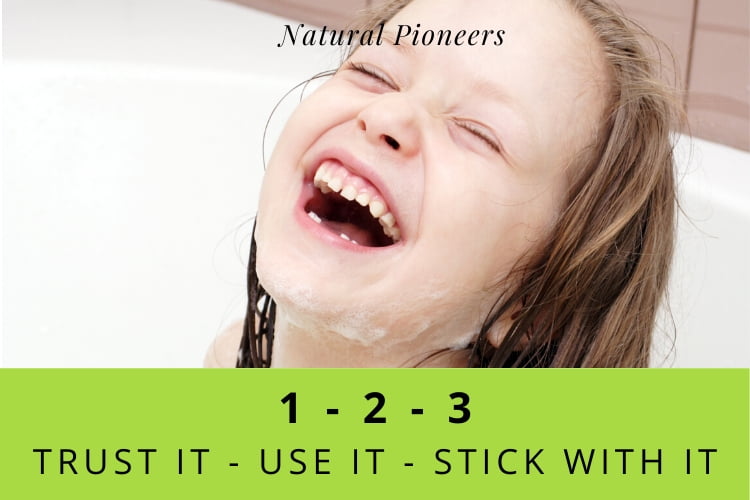
1. Tree To Tub Hydrating Foam Cleanser (Sensitive Skin)
Why We Love It:
- pH-balanced: 5.5
- Safe for people with sensitive skin, psoriasis, eczema, dermatitis, acne & rosacea
- Made with 100% natural lavender essential oil
2. Era Organics Cleanser & Restore Face Wash
Why We Love It:
- pH-balanced: 5.5
- Hypoallergenic
- Boosts healing and repair
3. Annmarie Aloe Herb Cleanser (all skin types)
Why We Love It:
- pH-balanced
- Recommended by physicians
- “Fall in love or money back guarantee” by Annmarie
4. Juice Beauty Blemish Clearing Cleanser
Why We Love It:
- All juice Beauty products are pH-balanced
- Deeply cleanseing and clarifying
- Bottled in recycled plastics – Thumbs up!
5. Drunk Elephant Pekee Bar
Why We Love It:
- pH-balanced: 6.51
- Gentle, multi-tasking bar that cleanses, tones and moisturizes
- Comes in a fun travel duo with case
5. Conclusion
Bar soap can definitely be used to wash your face. However, it is the formulation of a soap, cleanser, or face wash that determines whether it is suitable for our face.
Soap is made with fats or oils and lye, whereas face washes and cleansers, on the other hand, are made with synthetic detergents. From an environmental perspective, bar soap is the clear winner requiring significantly less chemical raw materials, being wrapped eco-friendly paper, and being more efficient to transport. Research also shows that bar soap lasts significantly longer as we use less.
The ideal soap, cleanser, or face wash supports our skin’s health. Studies show, that the most important biophysical parameters of healthy skin are the skin pH, epidermal hydration, transepidermal water loss and sebum excretion. We have found that choosing a non-toxic product with a pH of ≤ 5, and added hydrating & moisturizing ingredients is ideal for healthy skin.
The ideal soap, cleanser, or face wash has the following characteristics:
– It has a pH of ≤ 5,
– Is hydrating & moisturizing (think glycerin & Shea butter), and
– 100% non-toxic (free of sulfates, preservatives, fragrances, and retinyl palmitate)
Soap bars, cleansers, and face washes can be formulated in a pH-balanced, non-toxic & hydrating/moisturizing manner.
For soap bars, Natural Pioneers recommends the Pekee Bar. Ideal cleansers include Annmarie Aloe Herb Cleanser, Juice Beauty Blemish Clearing Cleanser, and Tree To Tub Hydrating Foam Cleanser. A face wash that matches all of our criteria is Era Organics Cleanser & Restore Face Wash.

